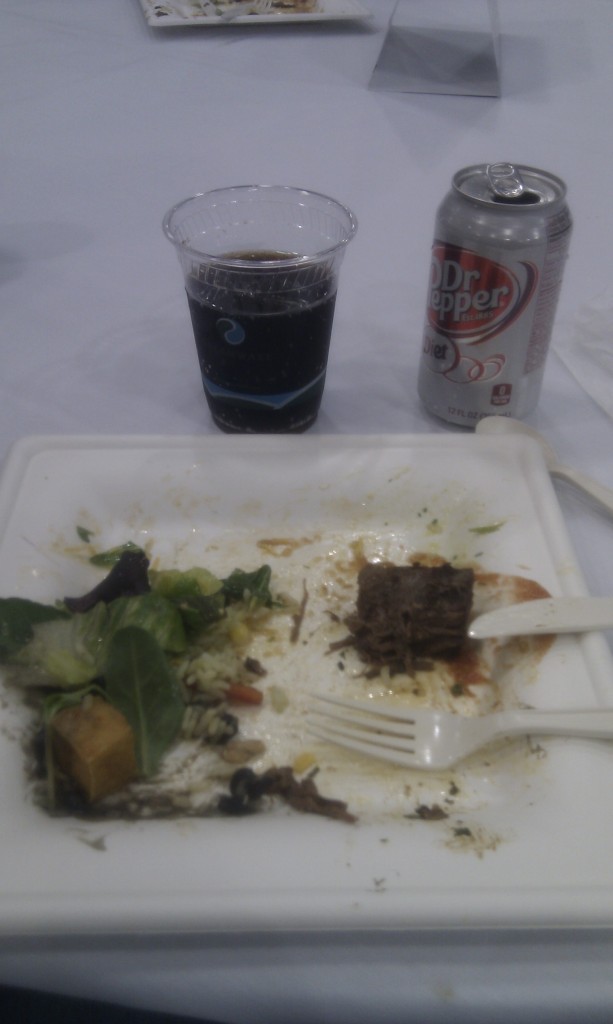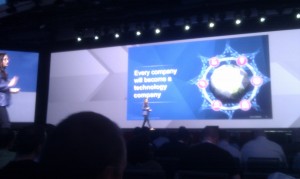This was my second day at the summit. Much more people than yesterday. It seems people really attending the summit have arrived. On monday morning, there was only DevNation. And now thousands of people queued to the breakfast stands for coffee and pastries. The Wifi connection suffers also from those many people carrying laptop or other connected devices.
Anyway, there were again very good presentations. Let me summarize them in this post. I notice that some videos of them are available on the Red Hat Summit Youtube channel.
Opening keynote
Like yesterday, it was an American show for this keynote. Three speakers gave their views on the evolution of IT for the coming years with big pictures in the backgrouond. There was in fact one talk from a Red Hat representative followed by presentations from Red Hat Summit sponsors: Cisco and Intel.
Paul Cormier, President of Product & Technology at Red Hat first reminded us how Linux and open source in general has been an asset since the beginning. His speak was in fact the occasion to tell the history of the infrastructure evolving from physical to virtual stations up to the cloud computing and how Linux and Red Hat products based on open source are participating to these trends. And then quoting the new Red Hat products: RHEL 7, Openstack, Openshift…
Padmasse Warrior, CTO from Cisco, came then on the stage with a presentation sharing the vision of her company on what are the current trends of IT. Her focus was on the Internet of Things that she nicely rephrased to “Internet of everything”. Hence the necessity to have a good robust infrastructure which can handle the big amount of data the set of interconnected devices will generate.
Finally, Douglas W Fisher from Intel, concluded the keynote by sharing his opinion on the next generation data center and the challenges which will become predominant in the coming years: security and privacy (and compliance to legislation), performance, uptime, cost, energy efficiency, storage, virtualization and finally data harnessing (aka big data).
Besides, his introductory video was funny, that is why I cannot resist displaying it into that blog post.
The future of middleware: Java, enterprise engineering and Fuse
Some big stars were on stage:
- Mark Little, VP of engineering at Red Hat
- Rob Davis, the technical director of Fuse engineering at Red Hat
- Jason Greene, the JBoss EAP architect (whose I attended a presentation yesterday, about
finalize()method. - Pete Muir, senior architect at Red Hat (I already saw him at a JUG on the Riviera where he did a presentation on CDI – that was in 2010 and his Scottish accent has not changed much since then)
Surprisingly enough, this talk was not very structured. We could have expected to get a roadmap of the JBoss middleware, but actually the speakers mostly shared their personal opinions concerning how Java middleware should be.
For Mark Little, multi-core, Internet of things, Rest-based architecture, cloud and modularity are now obvious trends. Java will always play a part in it, and most of all Java EE. But one cannot only rely on it since, according to him, technologies like Node.js or Akka seem to fill some gaps (e.g. asynchronous communications) Java EE is not entirely addressing. Hence the Vert.x initiative of Red Hat to get into that path.
Rob Davies emphasizes on the need to evolve toward micro-service architecture, some kind of SOA but without the implicit distribution. And for him, Fuse and Camel will play a substantial role in this direction.
Jason Greene’s point of view was more that the future dwells in the intelligent provisioning of resources while guaranteeing even load balancing, low costs, reliability, security…
Pete Muir ended the talk with the funny fact that he was less and less coding with Java and its consequent traditional tools (Eclipse, Maven…), then instead doing more and more of Javascript, Ruby… His point was that nowadays developers should be polyglot and opened to new languages and technologies.
Although it was interesting, I am a bit disappointed by these presentations since I would have expected more concrete facts, eventually in the Red Hat middleware product roadmap. But I guess this has maybe been done in other sessions.
Lunch

Lab: Automate your business with Red Hat JBoss Middleware integration & BPM
During this summit, I wanted to participate to a lab session, so I registered to this one. I believed it was one of the lab where I could have my hands dirty, doing some code.
It was in fact quite click-oriented… But anyway, it was interesting and the lab is quite well orgqnized. I was in a room where each participant has a computer and a tutorial to follow.
The topic? It was about BRMS (business rules management system) and BPM (business process management). I guess the Graal there is to have business analysts able to “code”: either by writing business rules in a BRMS (“if one pay $50, then apply a discount”) or by modelling the flow as diagram in a BPM system.
I admit BPM and BRMS systems have always interested me. I do not share the opinion that business analysts will eventually replace coders (what a nightmare…) but at least BRMS are fun (I like declarative programming and the inference algorithms) and I think BPM could be useful for monitoring and statistic purposes.
I played with the corresponding open source technologies years ago (Drools or jBPM) and with this lab I was quite impressed by the progress made since then, especially concerning the workflow execution monitoring and analytics part of BPM and also the web-based modelling of workflow.
The lab can be found here: http://summitlabs.onthe.rhcloud.com/
Unfortunately I could only do the first part during this 2-hour lab, but anyway, that was good and the trainer was very friendly.
What’s new with Red Hat JBoss Operations Network, Heiko W. Rupp & Thomas Segismont
In this session, it was mainly to introduce the new feature of the latest version of JBoss ON (aka RHQ for the open source version) – i.e. version 3.2. It was also the occasion of the JON developers present on stage to introduce what will be in the 3.3 version (targeted for around September).
So what is new with 3.2?
- New charts to display metrics (at least enhanced charts displayed in the UI)
- Storage of metrics move from RDMS to Cassandra
- A brand new Rest API is exposed by JON to access metric information or push metrics to JON
- a fine-grained bundle permission – so that it is now possible to set security roles per deployable bundles
And what about 3.3? Focus seems to be on limiting the footprint of the sensor agent and on a better support of JBoss EAP 6 monitoring and deployment over it.
All in all, that was a good presentation, very detailed at least. I was pleased to see that JON was used by quite a lot of people present in the room.
In fact, later in the day, I had the luck to intercept one of the speaker, Thomas, while in the corridor of the Summit. He is French and I discussed some of the concerns we have at work concerning monitoring and how we are surveying different solutions (including RHQ) for improving our monitoring. I particularly asked the questions about the convergence of Hawtio and JON which have big similarities. He answered me that the trend in in fact to converge, but the focus seems to be first the introduction of modularity into JON (e.g. the storage layer and the Rest API), so that it can be reused by Fuse products.
After that, I followed him to the “Bird of feather” session about JON. Here I learned that alerting in JON is quite customizable, so I think it would not be a problem if we have to interface with our in-house incident system. Some people also shared about their experience about JON. They are indeed numerous and are mostly using it for JBoss/Tomcat monitoring.
Recipes to analyze common performance issue, William Cohen
That was a DevNation presentation and I admit it maybe did not fit me very well.
The topic was about the performance measurement and what tools to use in which case. The presentation was good because it was a big catalog of which tools to use given the type of performance measurement you want to grab: processor speed, cache performance, memory bandwidth, network/storage bandwidth or latency, locking or synchronization… I find it would be useful to get the slide where everything was resumed. Let see if it is online someday…
But then the presentation went deep to the usage of some Linux tool that I did not know and was very low level: SystemTap, perf, OProfile…
I was a bit lost admittedly, but when I am lost in technical speech at the end of the day, I feel like listening to a nice poetry…
